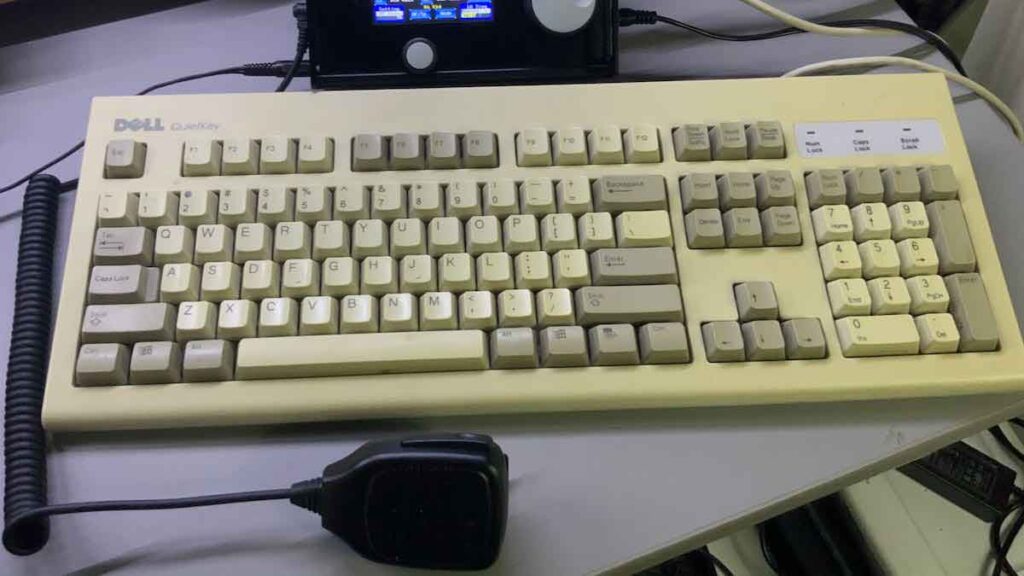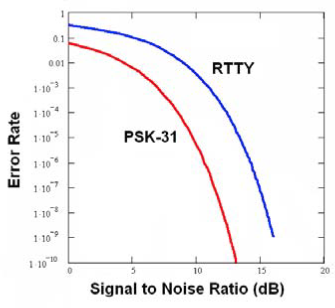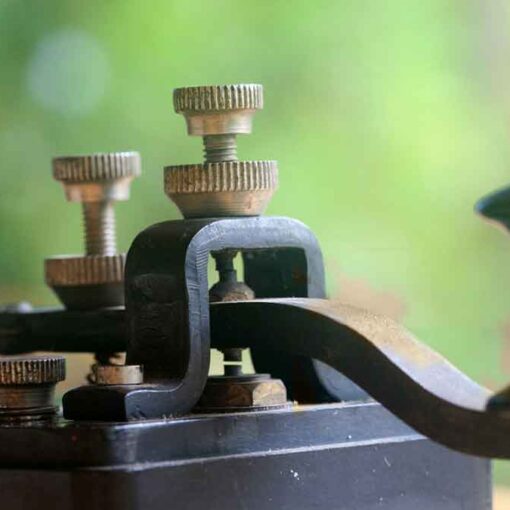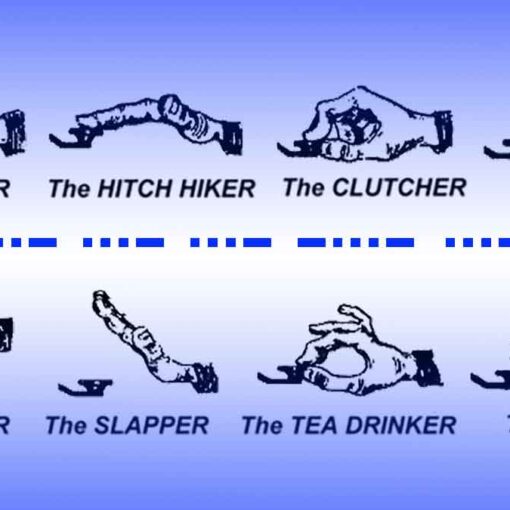
What is PSK31?
PSK31 is an error-correcting digital broadcast class designed for “keyboard-to-keyboard” communication via radio, combining the positive features of CW and RTTY.

For PSK31, computer is now a required attribute. This broadcast class uses the sound card in your computer to convert your keyboarded messages into a modulated audio signal, as well as to convert received PSK31 audio signals into text.
The PSK31 signal, operating at 31.25 baud (enough for hand-typed texts), theoretically fits into an extremely narrow band of 31 Hz at a level of -6 dB (in practice, the band width is approximately 80 Hz). PSK31 does not include an error correction algorithm. But at signal-to-noise ratios greater than 10 dB, PSK31 is virtually infallible. With a lower signal-to-noise ratio, PSK31 is approximately five times more reliable than RTTY.
Each character of the Bodot code used in RTTY uses a binary code made up of exactly 5 bits, meaning that all characters are the same length. PSK31, however, uses a variable code, meaning that the code is of variable length. Example: The letter “q” is encoded with a full 9 bits (“110111111”), while the letter “e” contains only 2 bits (“11”). The average length of all characters is 6.15 bits. Many of the PSK31 lowercase letters have fewer bits than the same uppercase letters, so the lowercase letters take less time to transmit.
Unlike RTTY, PSK31 signals do not contain start and stop bits. Instead of using two frequencies as in RTTY (which uses FSK), PSK31 uses a single frequency, but shifts the phase (by 180°) to transmit the logical ones 1 and 0.
Detailed information on this and other digital regimes can be found for example at: http://www.arrl.org/ FandES/field/regulations/techchar/
Frequencies for PSK31
The table below does not replace the IARU band plan, but gives an overview of the segments in the different bands that are actually used for PSK31.
Frequencies for PSK31 activity:
| 160 m | 1.838 – 1.840 kHz |
| 80 m | 3.580 – 3.585 kHz |
| 40 m | 7.035 – 7.037 kHz (7.080 in Region 2) |
| 30 m | 10.130 – 10.140 kHz |
| 20 m | 14.070 – 14.075 kHz |
| 17 m | 18.100 – 18.102 kHz |
| 15 m | 21.070 – 21.080 kHz |
| 12 m | 24.920 – 24.925 kHz |
| 10 m | 28.070 – 28.080 kHz |
Transmitter setup for PSK31
PSK31 is a very popular broadcast class, where with fairly low power and a simple antenna, excellent results can be achieved. Its inherent bandwidth is very narrow and so it is very easy for the transmitter to be overmodulated, resulting in a very wide signal. Therefore, it is especially important that the transmitter is set up correctly.
A few tips:
The audio processor and/or speech processor must be turned off at all times.
Plug the transmitter into USB (LSB is also acceptable, but normally USB is used).
Operate at no more power than necessary for a stable QSO.
Use an oscilloscope to observe the shape of the emitted signal. The figure shows what should be the waveform of a well-tuned PSK31 signal observed at the instant of a two-tone test used to measure the PEP (average radiated power at maximum modulating signal) of SSB.
When using 100 W power, the transmitter wattmeter should read 50 W, unless of course the transmitter is overmodulated. A 100 watt transmitter should produce 100 W PEP (not average power) over an extended period of time (the wattmeter will read 50 W). The average load of the amplifier (power stage) is 50%.
Small test rigs designed to monitor broadcast signal quality, the so-called PKSMETER on KF6VSG or IMDMETER on KK7UQ, are described respectively at http ://www.ssiserver.com/info/pksmeter/ and http://kk7uq.com/html/imdmeter. html. The useo such equipment or an oscilloscope is recommended.
Receive PSK31 signal
Some programs are capable of simultaneously decoding dozens of PSK signals. With such software, you can monitor a wide spectrum if you use a relatively wide-band filter (eg 2.7 kHz) in the receiver. All signals in this band will be decoded on the screen. This is the perfect way to work, monitoring the range when searching and swooping (back and forth from station to station).
If you want to dive into the noise or just work with stations on the same frequency, the narrowest bandpass filter on your receiver (eg 200 Hz) will improve your performance (better signal-to-noise ratio, avoiding sensitivity collapse the receiver due to the use of AGC, which in turn is triggered by a strong signal at a close frequency that the filter passes, less chance of intermodulation, etc.). In this case, the display will show you only one station.
Nominal frequency of PSK31
If you are working with a wide band, for example 2.7 kHz, it is easiest to tune your transceiver precisely to a round frequency, for example 14,070,000 kHz. When you select a station on the display (usually you have to click on the top), the software will display the nominal audio frequency of the selected station, for example 1.361 Hz. In this case, assuming you are running USB the broadcast frequency of this station is 14,070,000 kHz + 1,361 Hz = 14,071,361 kHz.
RSQ report
The traditional RST report is unsuitable for use in its original sense in digital broadcast classes such as PSK31 and easily leads many operators to use the popular 599 contention regardless of the true merits of the received signal. RSQ (Intelligibility, Loudness, Quality) has been adapted from RST to present a more valuable report at KB digital broadcast classes.
RSQ Comprehension: the detailed table (below) expresses the corresponding percentage of comprehensible text. This is in accordance with the common practice to exchange this percentage during each QSO.
RSQ Strength: most computer programs used in the KB broadcast digital classes provide monitoring of the entire signal spectrum. Hence, the apparent signal-to-noise magnitude has a greater value than the S-meter report, which averages the signal strength over the entire passband.
RSQ Quality: the presence of additional unwanted modulation traces in the signal spectrum are an indication of possible spurious emissions (mainly caused by overmodulation) and are a basis for evaluating the quality of digital signals.
RSQ report:
| Comprehensibility | |
| R5 | > 95% perfectly readable |
| R4 | 80% practically no difficulty, randomly missing characters |
| R3 | 40% significant difficulty, many missing characters |
| R2 | 20% randomly understood words |
| R1 | 0% illegible |
| Strength | |
| S9 | Very strong signal |
| S7 | Strong signal |
| S5 | Moderate signal |
| S3 | Weak signal |
| S1 | Almost unreceived signal |
| Quality | |
| Q5 | Clean signal – no unwanted side emissions |
| Q4 | A hard-to-spot pair of unwanted emissions |
| Q3 | An easily spotted pair of unwanted emissions |
| Q2 | Multiple Pairs |
| Q1 | Scattered across the spectrum |
(Source: http://www.rsa-info.net/)



